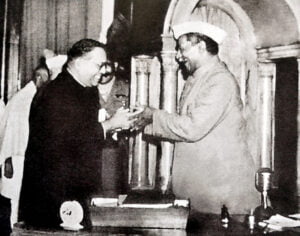The growth of power of the legislative assembly over time in British India was a result of the growing demands for self-government from the Indian people. The Indian independence movement played a major role in forcing the British government to grant Indians more power. It can be seen in the following stages:
- Indian Councils Act of 1861: This Act established Legislative Councils in each province of British India. The councils were composed of both appointed and elected members, but the proportion of elected members was very small.
- Indian Councils Act of 1892: This Act expanded the powers of the legislative councils and increased the number of elected members. However, the councils were still largely dominated by the British government.
- Government of India Act 1909: This Act introduced a system of dyarchy in British India, which gave the legislative councils more power in certain areas, such as education and healthcare. However, the councils still did not have full control over their respective provinces.
- Government of India Act 1919: This Act introduced a bicameral legislature at the central level, and also expanded the powers of the provincial legislative councils. It established two houses, i.e., a Central Legislative Assembly and a Council of State.

Dr. Babasaheb Ambedkar, chairman of the Drafting Committee, presenting the final draft of the Indian Constitution to Dr. Rajendra Prasad, President of constituent assembly on 25 November 1949. | Photo Credit: Mid-day Archive
The Central Legislative Assembly was the lower house of the bicameral legislature. It had 145 members, of whom 105 were elected and 40 were nominated. The elected members were elected by a system of indirect elections, in which voters elected representatives to electoral colleges, who then elected the members of the Assembly. The nominated members were appointed by the Governor-General.
The Council of State was the upper house of the bicameral legislature. It had 60 members, of whom 35 were elected and 25 were nominated. The elected members were elected by special constituencies, such as landholders, universities, and chambers of commerce. The nominated members were appointed by the Governor-General.
The bicameral legislature was a significant step forward in the development of Indian democracy. It gave Indians a greater say in the government of their country, including the decision of provincial budgets and helped to develop the skills and experience that would be needed for independent rule.
However, the bicameral legislature was also flawed. The system of indirect elections meant that the majority of Indians were not directly represented in the legislature. Additionally, the Governor-General’s veto power gave the British government too much control over the legislature.
- Government of India Act 1935: This Act introduced a system of provincial autonomy in British India. The provinces were now given a great deal of autonomy to govern themselves, and the provincial legislative councils were given the power to pass laws on a wide range of subjects.
It is important to note that the growth of power of the legislative assembly was not always linear. There were periods of setbacks and reversals. For example, the Government of India Act, 1935 was suspended during World War II. However, the overall trend was towards greater power for the legislative assembly.
By the time India gained independence in 1947, the legislative assembly had become the supreme legislative body in the country. It had the power to pass laws on all subjects, and it was also able to hold the government accountable.
The growth of power of the legislative assembly in British India was an important step in the development of democracy in India. It helped to prepare the country for self-government.
Continue to the next section: The System of Dyarchy
